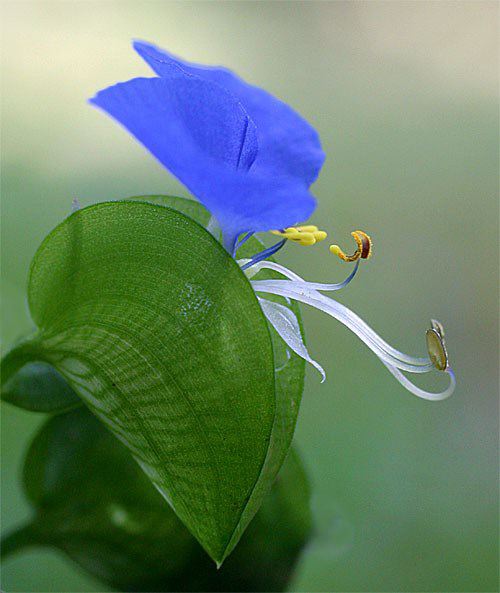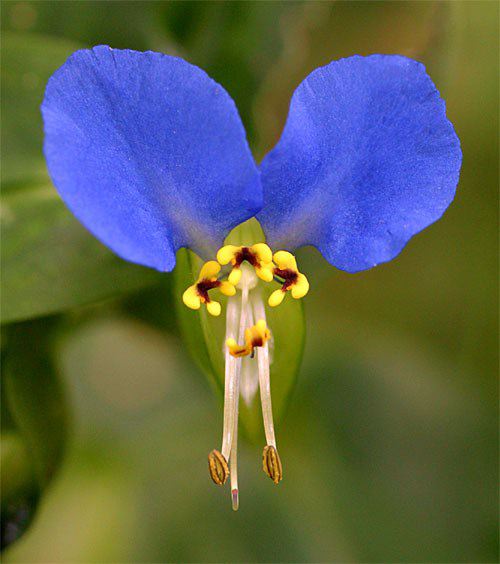|
|
|||
|
|
|||
Back to Preceding Week; on to Next Week
|
ASIATIC DAYFLOWER One of the bad things about being trained in ecology is that sometimes it gets in the way of our enjoyment of the world around us. That's especially true when it comes to our mixed feelings about non- native plants that on one hand are extremely pleasing to the eye but on the other are doing their darndest to crowd out native species. For example, Japanese Honeysuckle--Lonicera japonica--makes a little flower with an intoxicatingly pleasant odor, but the vine itself can strangle the living daylights out of good-sized saplings. At Hilton Pond Center we've made moderate progress in exterminating honeysuckle, but now the lovely Periwinkle--both Vinca major and Vinca minor, brought over long ago from Europe--have crept in and carpeted parts of the property so thickly that nothing else can grow. Fortunately, not all foreign invaders are quite as aggressive, and we have come to almost tolerate a little herbaceous plant called Asiatic Dayflower. 
All text & photos © Hilton Pond Center Dayflowers--as their name suggests--bear ephemeral blossoms attractive to bees and other smaller pollinators that have to work quickly, since in sunny weather the flowers open in early morning and disintegrate into a jelly-like mass by noon. Blooms last a bit longer in cooler, cloudy weather. Classified in the Spiderwort Family (Commelinaceae), dayflowers have a worldwide distribution, principally in the tropics. The Asiatic Dayflower, Commelina communis (above), is from east Asia but has invaded almost all of the U.S. except Nevada and the Pacific Northwest. Although it grows weedlike in warmer parts of its adopted range, it is actually cultivated under glass as an ornamental in Europe and cooler parts of North America. There are also three native Carolina species of Commelina, all of which at least superficially resemble Asiatic Dayflower. The most noticeable attribute of Asiatic Dayflower is two prominent sky-blue petals that stick out like mouse ears (bottom photo); in fact, across parts of its range it is known as "Mouseflower."
A head-on view of Asiatic Dayflower (bottom photo) shows the mouse-ear petals, plus a remarkably complex assortment of reproductive parts on a blossom that is only about an inch square. Blossoms of Asiatic Dayflower often glisten in the sun, sometimes from dew but primarily because the petals contain a few unpigmented cells scattered among the many that are blue. These clear cells--nearly bursting with water--reflect the light, adding all the more to the pleasing appearance of this non-native visitor to Hilton Pond Center. Thus far it only grows in the drain field from our septic tank, but we're ready to go after it with the weed-eater if it gets too rambunctious. For now we're content to tolerate--and appreciate--the short-lived blossoms of our bright blue Asiatic Dayflower. 
All text & photos © Hilton Pond Center Comments or questions about this week's installment?
"This Week at Hilton Pond" is written & photographed You may wish to consult our Index of all nature topics covered since February 2000. You can also use the on-line Search Engine at the bottom of this page. For a free, non-fattening, on-line subscription to "This Week at Hilton Pond," just send us an E-mail with SUBSCRIBE in the Subject line. Please be sure to configure your spam filter to accept E-mails from hiltonpond.org. |
|
Make direct donations on-line through
Network for Good: |
|
|
LIKE TO SHOP ON-LINE?
Donate a portion of your purchase price from 500+ top on-line stores via iGive: |
|
|
Use your PayPal account
to make direct donations: |
|
|
|
|
SPECIES BANDED THIS WEEK: * = New species for 2003 WEEKLY BANDING TOTAL 1 species 7 individuals
YEARLY BANDING TOTAL (2003) 46 species 811 individuals
BANDING GRAND TOTAL (since 28 June 1982) 123 species 42,925 individuals
NOTABLE RECAPTURES THIS WEEK (with original banding date, sex, and current age) None this week |
OTHER SIGHTINGS OF INTEREST --Six Ruby-throated Hummingbirds were banded at Hilton Pond Center on 30 Aug. That particular date has been by far the most productive over our 20 years of banding RTHUs, with a total of 72 hummers. The second best date is 4 Aug with 47 RTHUs banded.
VAGRANT HUMMINGBIRDS
A very early young female Rufous Hummingbird (above) was banded on 30 Aug at Indian Land in Lancaster County SC. |
 "HUMMINGBIRD MORNINGS" "HUMMINGBIRD MORNINGS"In 2004, informative and entertaining hummingbird banding presentations are already scheduled for Virginia, North Carolina & Kentucky/Tennessee. (Click on the logo at left for details.) If your group would like to host "Hummingbird Mornings" anywhere in the U.S. or Canada in 2004 or later, contact Bill Hilton Jr. |
|
Up to Top of Page Current Weather Conditions at Hilton Pond Center |
 post questions for The Piedmont Naturalist |
Join the |
Search Engine for |
|
|